“Should kids believe in Santa?” is a hot topic in Iceland at the moment. On one hand, critics say that we are lying to our children, and it is wrong to teach them to believe in a fictitious man who defies the laws of nature. On the other hand, supporters say that believing in Santa is part of what makes Christmas so special for children, and who are we to take that away from them?
Some people remember the exact moment when they found out Santa wasn’t real. I suppose for others it is more of a gradual realisation. Last Christmas a cousin of mine told me that I was responsible for her learning the truth. Back when we were young, we were at a family party and got into an argument about Santa’s existence. I launched a scientific expedition, and made her follow me to the basement where we saw “Santa” go into a room, and an older family friend came out! I had forgotten this, but it was a vivid memory for her. For me, I do remember my older sister spilling the beans to me the previous year.
Is believing in Santa ridiculous? Should it be stopped? My answer is probably not. Here are three reasons why:
1. Most importantly, believing in Santa is a FUN for children, and I believe it is harmless fun.
In Iceland you get a present for each of the 13 days leading up to Christmas, everyone of which is left in a shoe by one of the mischievous Yule Lads. I love seeing how excited my nieces get about the Yule Lads.
2. Children’s minds work differently than adult’s minds.
When we are very young, we are wildly creative, and we are willing to believe the impossible at the drop of a hat. This is part of normal childhood development. I feel that discovering the truth about Santa can be an important opportunity to teach children about critical thinking. As they age, kids need to learn not to believe everything they are told, and learn methods of distinguishing truth from fiction. It can even be fun. For example, when my husband was young, he and his sister collected handwriting samples from all the adults in the house, and asked Santa to leave a note. On Christmas day th
ey set up a forensic lab to compare the handwriting samples! Instead of feeling lied to and betrayed, they enjoyed the process of discovery. (You won’t be surprised to hear that they both went on to careers in science and research.)
3. The Icelandic Yule Lads give parents a perfect opportunity to apply general behaviour principles on their kids.
Kids learn that positive behaviour (e.g. such as going to bed on time) can lead to a reward (e.g. a new toy in their shoe in the morning). One of my favourite books on the topic is called the Power of Reinforcement. It points out that instead of the “carrot and stick” approach, the “carrot, carrot and more carrot” can be best. Perhaps that’s why there are 13 Santas in Iceland?

Apparently a lot of mail directed to the “North Pole” ends up in this huge box in Greenland. If a little child has gone to the effort of writing a letter to Santa, I’d be the last person to break their little heart with the truth. I think my time would be better spent asking grown adults why they believe in things that are equally improbable.

Fjola Helgadottir, PhD, MClinPsych, is a clinical psychologist, a senior research clinician at the University of Oxford, and is a co-creator of AI-Therapy.com, an online CBT treatment program for overcoming social anxiety